
The LG Optimus Quantum smartphone is the only Windows Phone 7 device that sports a keyboard. At least the only one released here in Canada with a keyboard. The design of the Quantum is very typical of previous Windows Phone/Mobile devices with keyboards. It’s a side-slider, meaning the keyboard slides out to the side and you need to rotate the device in order to use the keyboard. I’ll get into the details of the keyboard in a little bit. First let’s cover off the specifications of the phone.
The Quantum comes with 1GHz SnapDragon processor, a 3.8 inch 800×400 screen that supports 262K colours. It weighs in at 180 grams, and measures 119.5 x 59.5 x 15.22mm. The Quantum supports Quad-band GMS / EDGE networks using 850/900/1800/1900MHz and Tri-band UMTS/HSPA using 850/1900/2100MHz. Other features include wireless b/g support, 16GB internal storage with no external MicroSD slot for expansion, a 5 MegaPixel camera with LED flash capable of taking a 720p HD video, 1500mAh battery, FM Radio, and Bluetooth. The Quantum also supports DLNA-DMR for streaming your media from the phone to any DLNA enabled monitor.
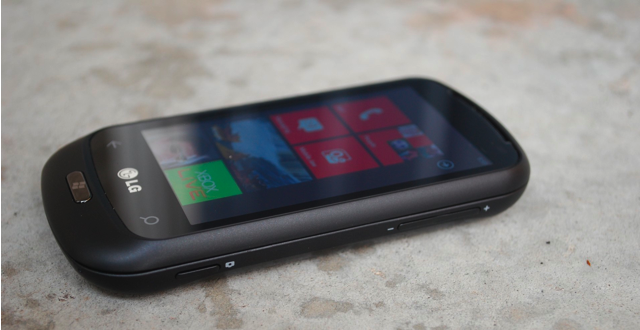
Two things hit me when I first received this phone. One of those is weight – the Quantum weighs in at 180 grams. If you compare that to it’s brother – the LG Optimus 7 at 157 grams, or the Samsung Focus at just 121 grams, and lastly, the HTC Surround at 165 grams – it’s obvious that the Quantum is the heavy one on the Windows Phone block. For reference, the iPhone 4 weighs in at 137 grams. But you don’t need to compare the numbers, just pick it up and you’ll notice right away; This is one of the heaviest phones you’ve held in your hand in recent years. I understand that this phone has a keyboard so it may not be fair to compare it to these phones. I wanted to show the weight compared to other Windows Phone 7 devices, and of course, the iPhone is popular so that reference is understandable. For those that think the extra weight is a result of the keyboard, the HTC Desire Z comes in at 164 grams. LG Quantum is still the winner, or loser, depending on how you look at this.
Weight is one of those magical things – if it’s too light then people tend to think it’s cheap feeling, and if it’s too heavy then it gives the impression of bulk and carrying a brick. For me, this device was just too heavy. Your mileage may vary, so I strongly suggest you head down to your local Bell store and pick one up for yourself. But for me, it was at that weight where I can’t forget that it’s in my pocket.
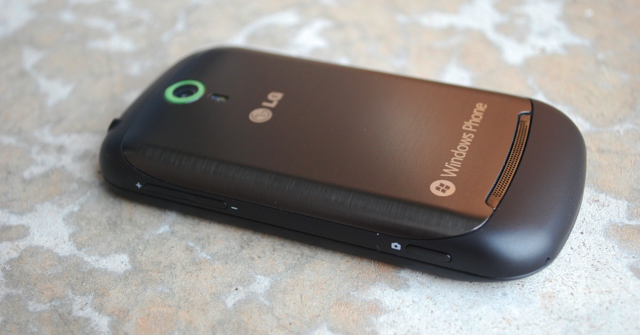
The other thing that hits you right away is the finish on the device. LG made the battery door out of very thin metal, which feels nice in your hand, but they covered everything else with that soft rubbery feel. It’s great to help prevent the device from slipping out of your hands, and if LG had only used this on the back around the battery door it wouldn’t be a problem. Unfortunately, LG covered the whole device with this soft rubber finish, including the front. The end result is that the phone looks like it has a poorly made rubber case on it all the time. Every time I looked at the device, I wanted to take the case off, only to remember that it wasn’t a case at all.
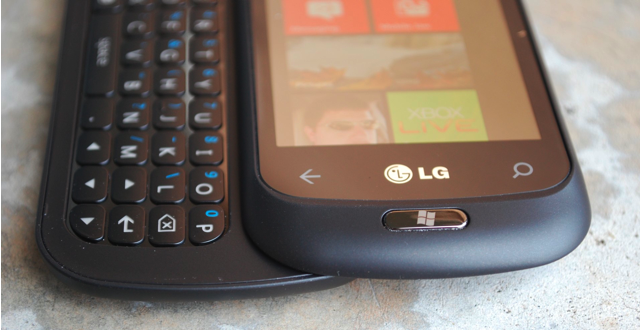
Let’s take a close look at the keyboard; The Quantum’s keyboard slides out to the left. It has 3 rows of letters and a row of symbol keys. In order to enter a number, you need to press the function button and then the corresponding key. The function and shift keys are off to the side of the keyboard and can be a little difficult to press because of their size and height, but nothing too dramatic. While the keyboard doesn’t sport an offset design, it is still very functional and I found it pretty easy to use. The keys have a good amount of travel and a spaced nicely.
Battery life on the Quantum was very nice. I had 4 email accounts (2 Exchange, 2 Gmail) linked on the phone along with my Facebook, and Windows Live accounts and I would have plenty of juice left at the end of the day. I could go a second day if I had to, without a problem.
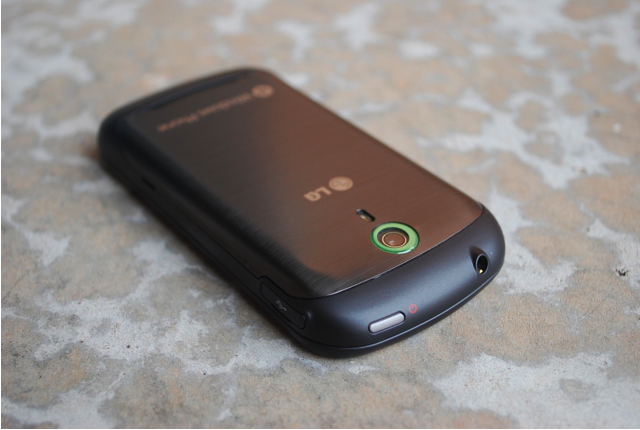
The top of the device has the 3.5mm headphone jack and the power button. On the right side of the device, you’ll find the volume rocker at the top end and the camera button about three quarters of the way down the side. The bottom of the device is clean and clear. And the left side of the device has a little thumbnail opening where you can pop open the battery door, and then closer to to top of the side is a microUSB plug for charging and syncing the phone.
Across the front of the device you’ll find the standard 3 buttons – Back, Home, and Search. LG made the Home button a true resistive button that requires pressing, while the Back and Search keys are capacitive buttons that just require you to touch them. There’s little chance you will accidentally press the Home button while reach across the device for the Back button. LG has also offset the Home button – it’s sits below the screen and below the Back and Search keys.
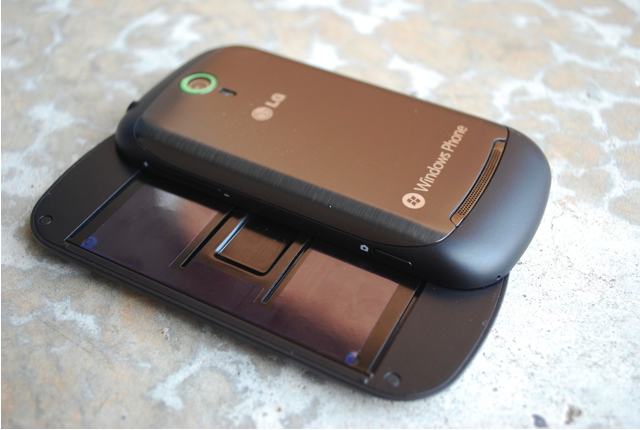
No surprise that you’ll find the camera on the back of the device. I was a little surprised at the location of the flash, it seems to be set a little far into the device. But it didn’t seem to effect the pictures at all.
The battery door on the Quantum is pretty unique. It’s kind of a hinge, but not really. It’s different enough that LG felt the need to put an instructional sticker on the back of the device. When you put your thumbnail in and pop the back cover, it swings out a little and then releases. When you put it back on, you need to be sure to get the hinged side lined up first, and then swing the door down and snap it into place. Once you’ve done this it’s pretty easy and not a problem to open/close. It’s just a little different the first time.
The screen on the Quantum is bright and vibrant and very responsive to the touch. While it may not be an AMOLED, it certainly is a vibrant screen that is easy enough to see indoors and out.
The LG Quantum is a solid phone with a really good slide out keyboard. The phone is fast both on data speeds and when running applications. The weight of the device is a bit much for me, and the rubberized finish left a lot to be desired, but your mileage might vary. Head down to your local Bell shop (or AT&T if you’re in the US) and check it out – especially if you fancy physical keyboards instead of on-screen type.
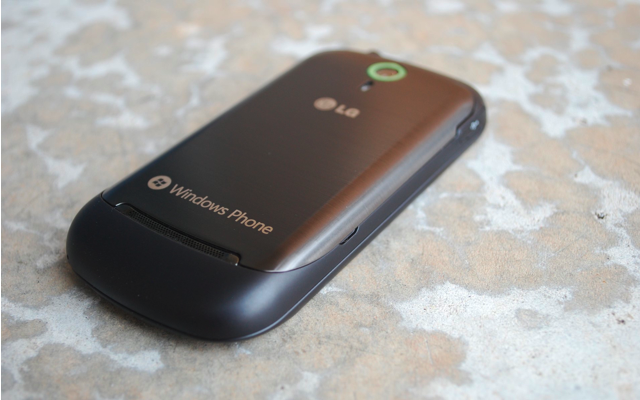
MobileSyrup may earn a commission from purchases made via our links, which helps fund the journalism we provide free on our website. These links do not influence our editorial content. Support us here.


